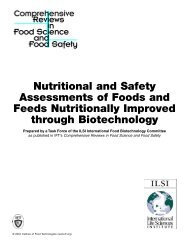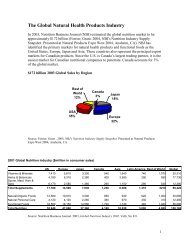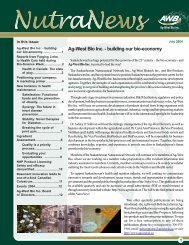Beyond Borders: Global biotechnology report 2010
Beyond Borders: Global biotechnology report 2010
Beyond Borders: Global biotechnology report 2010
You also want an ePaper? Increase the reach of your titles
YUMPU automatically turns print PDFs into web optimized ePapers that Google loves.
of factors, including a change in accounting<br />
rules, contributed to the large uptick in US<br />
profitability, but cost reductions certainly<br />
played a significant role. It is also worth<br />
noting that, while increased profitability<br />
was most dramatically apparent in the US,<br />
the bottom line in each of the other<br />
established centers — Europe, Canada and<br />
Australia — improved significantly in 2009.<br />
Operating efficiency, it would appear, is an<br />
integral part of the new normal.<br />
That drive for efficiency was also clearly<br />
visible in the industry’s survival index,<br />
which measures the number of years of<br />
cash that companies have on hand based<br />
on their current cash burn. In 2008, the<br />
survival index had deteriorated considerably<br />
as many companies had a difficult time<br />
raising capital. But in 2009, thanks to the<br />
efforts to reduce cash burn (as well as the<br />
success some companies had in fund-raising<br />
transactions) the survival index bounced<br />
back in the US and Europe, though there<br />
was no appreciable improvement in Canada.<br />
United States<br />
As mentioned above, the financial results of<br />
the US <strong>biotechnology</strong> sector were skewed by<br />
the megadeal of the decade — the acquisition<br />
of Genentech by Roche. At the time of the<br />
transaction, Genentech accounted for more<br />
than 20% of the revenues of the US publicly<br />
traded biotech industry, so it is not surprising<br />
that the transaction had a sizeable impact on<br />
the industry’s results.<br />
The revenues of US public companies<br />
fell to US$56.6 billion in 2009, a 13%<br />
drop compared to 2008. After removing<br />
Genentech from the 2008 numbers, the<br />
industry’s revenues would have instead<br />
increased by 10%; adjusting for Sepracor,<br />
the year’s other significant acquisition<br />
would have raised the growth rate even<br />
further, to 12%. This is fairly consistent with<br />
2008, when the industry’s revenues grew<br />
by 8.4%, or 12.7% adjusted for significant<br />
acquisitions. In addition to the acquisition<br />
of Genentech, the industry’s revenues were<br />
impacted by declining revenue at a couple<br />
of industry stalwarts: Amgen (which saw<br />
revenues decline because of a significant<br />
decline in sales of Aranesp, driven by a<br />
product safety-related label change that<br />
occurred in August 2008) and Genzyme<br />
(which was negatively impacted by<br />
manufacturing problems for Cerezyme and<br />
Fabrazyme).<br />
R&D spending decreased by 24%, compared<br />
to a 20.5% increase in 2008. After adjusting<br />
for the Genentech acquisition, R&D<br />
expenditures would have still decreased<br />
by 13%. Companies <strong>report</strong>ing significant<br />
reductions in R&D spending included<br />
Amgen, Celgene and United Therapeutics.<br />
However, the trend was fairly consistent<br />
across the industry, with 64% of companies<br />
<strong>report</strong>ing reductions in R&D spending. In<br />
contrast, back in 2007, before the onset of<br />
the financial crisis, only 37% of US public<br />
companies reduced R&D spending during<br />
the year.<br />
As mentioned above, the truly noteworthy<br />
development in the US industry was its<br />
profitability. The net income of publicly<br />
traded biotech companies increased from<br />
about $US400 million in 2008 to an<br />
unprecedented US$3.7 billion in 2009.<br />
This is all the more impressive given<br />
that the acquisitions of Genentech and<br />
Sepracor had removed US$3.9 billion of<br />
profits from the industry.<br />
The remarkable uptick in profitability<br />
was driven by a combination of factors.<br />
The first of these is a seemingly arcane<br />
change in accounting rules, but one with<br />
significant implications for the biotech<br />
industry: the treatment of acquired inprocess<br />
R&D (IPR&D). Large acquisitions<br />
by US biotech companies have typically<br />
resulted in hefty charges for acquired<br />
IPR&D — essentially the estimated fair<br />
value assigned to ongoing R&D projects<br />
acquired in a business combination. Given<br />
the active deal environment in recent years,<br />
the US industry’s profitability has been<br />
lowered every year by these significant<br />
charges. In 2008, for instance, US biotech<br />
acquirers incurred about US$2.3 billion in<br />
acquired IPR&D charges, in the absence<br />
of which the industry would have been<br />
very comfortably in the black. Starting in<br />
January 2009, however, the accounting<br />
treatment of acquired IPR&D changed.<br />
Instead of <strong>report</strong>ing IPR&D as an expense<br />
on the income statement, US companies<br />
are now required to capitalize it as an asset,<br />
eventually amortizing the assigned value<br />
to expense. While the rule changes create<br />
several challenges for companies entering<br />
deals (see “Valuing milestones,” by Michelle<br />
Mittelsteadt, on page 79 for a detailed<br />
discussion), the absence of acquired IPR&D<br />
charges gave an immediate boost to the<br />
industry’s net income in 2009.<br />
The reduction in the number of public<br />
companies also helped the industry’s<br />
profitability, since the majority of<br />
companies that were acquired or ceased<br />
operations during the year were in a<br />
net loss position. In aggregate, these<br />
companies had racked up net losses of<br />
approximately US$850 million in 2008,<br />
and their removal boosted the industry’s<br />
bottom line by a similar amount.<br />
The sum of all these factors, however, is<br />
not sufficient to account for the magnitude<br />
of the increase in industry profits in<br />
2009. Much of the difference came from<br />
one-time events such as asset sales, tax<br />
benefits, milestones and royalty payments<br />
as well as increased efficiencies at large<br />
numbers of companies across the industry.<br />
Noteworthy examples include industry<br />
leaders such as Amgen and Gilead, which<br />
57








